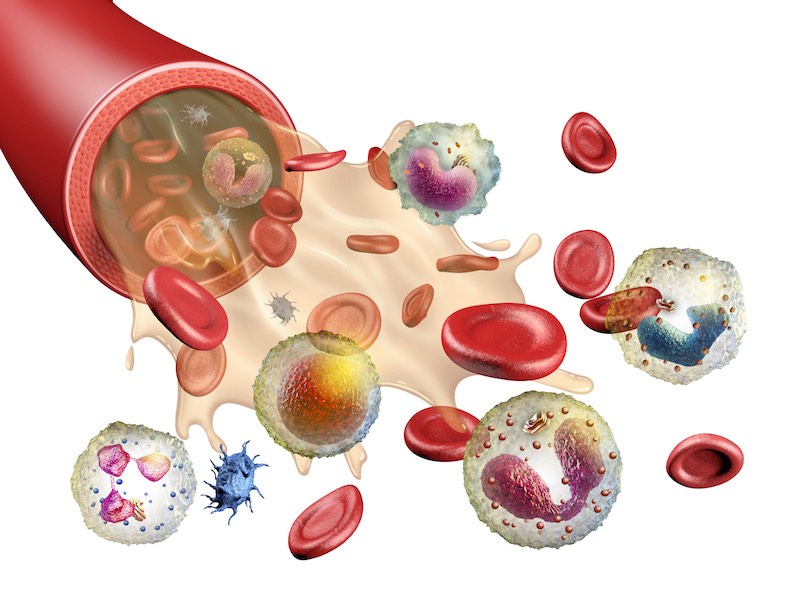Genetics drive deep investigations into blood cell production

Knowing how different kinds of blood cells form from their stem cell progenitors can shed light on blood disorders and aid in finding new treatments. A series of recent studies co-led by researchers at Dana-Farber/Boston Children’s Cancer and Blood Disorders Center applied a variety of genetic tools to provide new insights on blood cell production.
In Nature Communications on June 3, team led by Luca Biasco, PhD, at Dana-Farber/Boston Children’s (now at University College London) and Allon Klein, MSc, PhD, of Harvard Medical School studied early blood formation in humans. To pin down when and how different blood cell lineages branch off, they performed RNA sequencing on individual cells. While lower-resolution lineage maps have already been created using single-cell RNA sequencing, this study went further, examining not only blood-forming stem cells carrying the classical CD34 marker, but other undifferentiated cells in the bone marrow. This provided a higher-resolution map of early blood formation and filled in details about the emergence of the white blood cells known as basophils.
The study also highlights the biological relevance of the human marker CD164, suggesting that it could be used to select a subpopulation of blood progenitor cells that might improve stem cell transplantation and gene therapy. (First authors Danilo Pellin, PhD; Mariana Loperfido, PhD, Dana-Farber/Boston Children’s.)
Gleaning insights from GWAS
In three recent studies, Vijay Sankaran, MD, PhD, of Dana-Farber/Boston Children’s and his collaborators mined data from genome-wide association studies (GWAS) to uncover clues about blood cell formation and how it goes awry in disease.
In work published in March in Nature Genetics, Sankaran and Jason Buenrostro, PhD, of the Broad Institute analyzed GWAS data from about 115,000 people in the U.K. Biobank. Looking at 16 different blood cell traits, they applied a technique called genetic fine-mapping to identify variants that were likely to be causal. Then, across all steps of blood production, they overlapped these variants with data on accessible chromatin (the packaging of DNA and how it loosens and tightens to allow genes to turn on or off). This analysis provided unexpected insights into normal blood cell production and how it varies, with implications for understanding blood diseases such as anemia.
In addition, the team developed a new technique called g-chromVAR that helps uncover likely causal variants and the relevant cell types in which they act, with broad implications for understanding a range of diseases and traits. (First authors: Graduate students Jacob Ulirsch, Caleb Lareau, and Erik Bao, Dana-Farber/Boston Children’s and the Broad Institute)
Red-cell regulators
In a study published in eLife on May 9, Sankaran and colleagues used data from GWAS and a functional screen of red blood cell production to identify 77 genes that may underlie variation in red blood cell traits. The study identified regulators of red blood cell production and variation in this process, while also providing potential insights into the variable severity of blood diseases like myelodysplastic syndromes and Diamond-Blackfan anemia. (First authors: Satish Nandakumar, PhD, and Sean McFarland, PhD, Dana-Farber/Boston Children’s and the Broad Institute.)
Finally, in Cell Reports on June 11, a team led by Sankaran and Aviv Regev, PhD, of the Broad Institute, dove into how blood-forming stem cells can differentiate to produce red blood cells. The researchers applied RNA sequencing to see which genes turn on and off during different stages of cell differentiation, starting with blood stem and progenitor cells. At each stage, they also applied accessible chromatin profiling to further identify regulators of cell identity. Their work revealed GATA1, KLF1 and, at the end stage, TMCC2, as important regulators, and also provides clues to how certain genetic variants found by GWAS may contribute to blood diseases such as anemia. (First authors: Leif Ludwig, MD, PhD, and graduate student Caleb Lareau, Dana-Farber/Boston Children’s and the Broad Institute.)
“All three of these studies explore how both common and disease-associated genetic variations in blood cell production can be used to gain a deeper understanding of this process,” says Sankaran. “They illuminate how we can take the rich information from GWAS and glean biological insights about blood formation and blood disorders.”
Related Posts :
-

A case for Kennedy — and for rapid genomic testing in every NICU
Kennedy was born in August 2025 after what her parents, John and Diana, describe as an uneventful pregnancy. Soon after delivery, ...
-

The journey to a treatment for hereditary spastic paraplegia
In 2016, Darius Ebrahimi-Fakhari, MD, PhD, then a neurology fellow at Boston Children’s Hospital, met two little girls with spasticity ...
-

New research paves the way to a better understanding of telomeres
Much the way the caps on the ends of a shoelace prevent it from fraying, telomeres — regions of repetitive DNA ...
-

AI-designed proteins open doors to new immunotherapies
Artificial intelligence (AI) is increasingly helping drive advances in science and medicine — including cellular signaling. In a recent study, published ...





